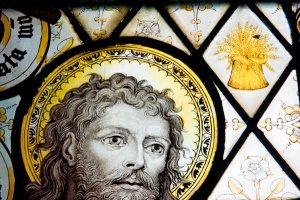
Charles Eamer Kempe was born on 29 June 1837 at Ovingdean Hall, West Sussex. He had illustrious ancestors; his first cousin was a successful property developer and politician in nearby Brighton, and his grandfather was Lord Mayor of London. The young Kempe was educated at Pembroke College, Oxford, where he first encountered the Tractarian philosophy that was gaining prominence in the mid-Victorian period.
Kempe briefly considered entering holy orders, but a habitual stammer made it clear that his future did not lie with preaching. He decided to turn his spiritual beliefs to a practical purpose, and decided to study architecture.
He studied under one of the leading church architects of the day, GF Bodley, and there developed his keen sense of medieval design and an abiding interest in stained glass. It is thought that Kempe's interest in stained glass stemmed from his dissatisfaction with the glass he ordered from a supplier. He decided that he could do better - and he was right.
Kempe travelled around Britain and overseas, sketching medieval window designs. Kempe assisted Bodley on two major church projects in the 1860s; All Saints, Cambridge, and St John's, Liverpool. In 1866 the important stained glass makers Clayton and Bell asked Kempe to design a memorial window for Bishop Hooper in Gloucester Cathedral. The rest, as they say, is history.
In 1866 he started his own business in London. Kempe Studios began by supplying vestments, stained glass, and church furnishings. The studio was a success and enjoyed continual growth throughout the late Victorian period.
You could say that he was fortunate, for Kempe Studios began in a period when church architecture and rebuilding was in vogue; the spiritual Renaissance of the Victorian period led to many medieval churches being rebuilt. So suppliers of materials and architectural knowledge were in great demand, and Kempe's work, particularly with stained glass, found a ready market of buyers.
Kempe decided early on that he needed to use a trademark, and he chose a wheatsheaf, which appears in the Kempe family coat of arms. Finding the wheatsheaf in a set of Kempe windows is a strangely enjoyable pastime for people who enjoy exploring Victorian churches! Kempe was especially active in his native Sussex, where fully 116 churches boast examples of his work.
He did not just deal in stained glass, though it is for glass that Kempe is best known. Some of his most important work was with wall painting, such as that at Staplefield, outside Horsham, West Sussex. Aside from the wheatsheaf trademark, one of the characteristic features of a Kempe design is a strong predominance of yellow.
Kempe's designs - particularly those in stained glass - helped define the style of an age, closely associated with the artwork of the Pre-Raphaelites. When you see a Victorian stained glass window, with its clear, clean colours and romanticised figures, you may not be seeing a Kempe design, but you are almost certainly seeing a design influenced by Kempe.
Kempe died in 1907, and his company was taken over by WE Tower. But Tower did not enjoy the same success as Kempe, and the company folded in 1934.
Kempe never married; he was a shy man by nature, though he enjoyed entertaining guests at the house he purchased at Lindfield, West Sussex. He is buried in the churchyard at Ovingdean, the place of his birth.
FACTS AND FIGURES
Kempe studios produced over 4,000 stained glass windows
He also designed altars, altar frontals, church furnishings and furniture, lych gates, and memorials
Cathedrals at Chester, Gloucester, Hereford, Lichfield, Newcastle upon Tyne, Winchester, and York contain works by Kempe
See: Kempe window in our Illustrated Dictionary of Church Architecture
And attractions tagged with 'Kempe'



